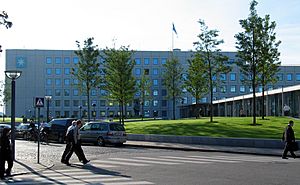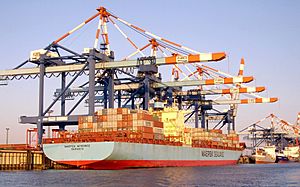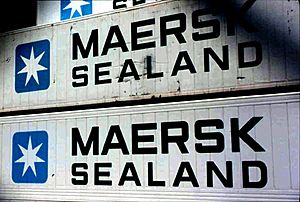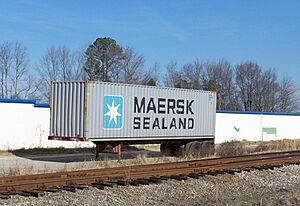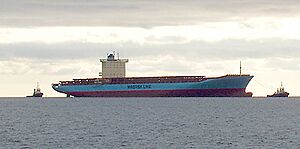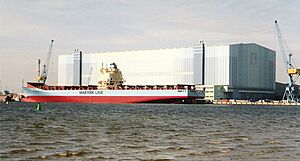History of Maersk facts for kids
The A. P. Moller-Maersk Group, often just called Maersk, is a huge international company. It's famous for shipping goods all over the world. This article tells you about how Maersk started and grew over the years.
The story of Maersk began in 1904. A sea captain named Peter Mærsk-Møller and his son, Arnold Peter Møller, started a shipping company called Dampskibsselskabet Svendborg in Svendborg, Denmark. Arnold Peter Møller's son, Mærsk Mc-Kinney Møller, later joined the company in 1939. After his father passed away in 1965, Mc-Kinney Møller became the boss and led the company for many years.
Contents
Maersk's Early Years (1886–1945)
- 1886: Captain Peter Mærsk-Møller bought his first steamship, the SS Laura.
- 1904: The Steamship Company Svendborg was officially started by Peter Mærsk-Møller and his son, Arnold Peter Møller. Their first ship was a cargo steamer named Svendborg.
- 1912: A.P. Møller started another company called Steamship Company of 1912.
- 1918-1919: A.P. Møller built his own shipyard, the Odense Staalskibsvaerft, near Odense. This is where they would build their own ships.
- May 1920: The new Odense Yard delivered its first ship, the Robert Mærsk.
- 1921: The Odense Yard built its first ship that ran on diesel, the Leise Maersk.
- 1926: A.P. Møller started getting into the business of carrying oil in large ships called tankers.
- 1928: A.P. Møller launched the first regular shipping service under the name Mærsk Line. They used six motor ships to carry goods across the Pacific Ocean, from the Far East to the US West Coast, and through the Panama Canal to Baltimore.
- Feb. 1928: Maersk received its first tanker, the Emma Mærsk.
- March 1928: The Odense Yard built its first tanker, the M.T. Anna Mærsk.
- 1934: The cargo ship Nora Mærsk was built, but sadly, it sank two years later because of a fire.
- Dec. 1936: The Eleonora Mærsk became the biggest ship in the Maersk fleet and the largest single-crew motor ship in the world.
- Sept. 1939: When World War II began, A.P. Møller was the second largest shipping company in Denmark, with 46 ships.
- April 1940: As Germany invaded Denmark, A.P. Møller sent a special message to all 36 Maersk ships at sea. They were told to report to the New York office and follow its orders, not Copenhagen. Mærsk Mc-Kinney Møller and his wife left Denmark and managed the New York office during the war.
- June 1941: The United States took control of foreign ships, and the Maersk fleet helped the US Navy during the war. More than half of Maersk's ships were lost during this time.
- 1943-1944: During the war, some of A.P. Møller's factories, which had been involved in making weapons, were sabotaged by the Danish resistance movement.
Rebuilding After World War II (1945–1965)
- June 1945: After World War II, Maersk's fleet was much smaller, with only seven ships left. Many others were still under US control.
- Oct. 1945: The Danish government passed laws to make companies that had made too much money by dealing with Germany during the war pay some of it back. Maersk companies were fined about 10 million Danish kroner.
- 1947-48: Maersk started a big program to build new ships. They ordered vessels from shipyards in many countries.
- 1953: The Chastine Mærsk became the first of 13 new, fast cargo ships. The Maersk fleet was now as big as it was before the war.
- 1954: The Regina Mærsk tanker was launched. It was the biggest ship ever built at the Odense Yard and the first Maersk ship with a blue hull.
- 1959: A brand new, larger shipyard, the Odense Lindø Yard, opened. It had huge docks for building very big ships.
- 1961: The first ships built at the new Lindø yard were five large tankers.
- 1962: The Danish government gave A.P. Møller permission to search for oil in the North Sea. A new oil company, Mærsk Olie og Gas A/S, was later created.
- 1964: The company Dansk Supermarked A/S was founded, marking Maersk's entry into the retail business.
Mærsk Mc-Kinney Møller Takes Charge (1965 – 1993)
- 1966: The old Odense Yard closed after building its last ship, the Laura Mærsk.
- 1967: A.P. Møller built its first supply vessel, the Mærsk Supplier, which helps other ships.
- 1967: The Odense Lindø Yard was made even bigger with a new construction dock and a huge crane. This allowed them to build giant tankers and, later, very large container ships.
- 1969: Maersk Air was founded, and it started flying planes the next year.
- July 1971: The Odense Yard built the Regina Mærsk, which was the biggest ship in Europe at the time.
- 1973: Maersk Line added its first container ship, the Svendborg Mærsk, to its fleet. Container ships carry goods in large metal boxes called containers.
- July 1974: The Odense Yard built the Kristine Mærsk, the biggest tanker in Europe.
- 1975: The Clara Mærsk ship rescued 3,500 refugees from the Vietnam War and brought them to Hong Kong.
- April 1979: A new main office for the company was finished in Esplanaden.
- January 1981: Maersk Line started its own container service between Europe and the Far East with the Laura Mærsk, the first container ship built at the Odense Yard.
- 1988: A.P. Møller opened a factory in Denmark to make containers.
- April 1988: The Odense Yard built the Marchen Mærsk, which was the largest container ship in the world at that time.
- 1989: Maersk Line introduced a new standard size for containers: the 45-foot container.
- 1992: The Inger Mærsk, a large ship for carrying gas, joined the fleet.
- Dec. 1992: The Odense Yard built the Eleo Mærsk, the world's first tanker with a double hull, which makes it safer.
Getting Bigger and Bigger (1993 – 1999)
- March 1993: Maersk Line took over another shipping company, EacBen Container Line Ltd. This made Maersk the largest container shipping business in the world.
- Jan. 1996: The Regina Mærsk was delivered from the Odense Yard. It was the world's largest container ship at the time, being over 300 meters long and carrying more than 6,000 containers.
- May 1996: Maersk started a new global container service with the Sealand Corporation.
- Sept. 1997: The Sovereign Maersk was delivered. It was the world's first container ship that could carry over 8,000 containers and was 346 meters long, making it the longest ship in the world at that time.
- Jan. 1998: The A.P. Møller Group bought a shipyard in Germany called Volkswerft. They modernized it to build container ships and other vessels for Maersk.
- February 1999: Maersk took control of the Safmarine container line, which included many container vessels.
- 1999: Maersk received its first ship built in mainland China, a tanker from Guangzhou Shipyard International.
Maersk-Sealand and Beyond (1999 – Present)
- November 1999: Maersk bought the container shipping company Sea-Land Corporation. The new combined company was named Mærsk Sealand.
- June 2001: Maersk bought a Dutch company that specializes in rescuing ships, Smit-Wijsmüller. This made the Maersk group the largest operator of salvage and offshore vessels in the world.
- September 2002: Maersk took over the shipping routes of another Danish company, Dampskibsselskabet TORM.
- 2003: The two original holding companies, Dampskibsselskabet Svendborg A/S and Dampskibsselskabet af 1912 A/S, merged to form A.P. Møller-Mærsk A/S.
- March 2003: The Odense Yard built the Axel Mærsk, which was the world's biggest and longest container ship at the time, with the largest cargo capacity. It was the first container ship over 350 meters long.
- April 2004: Maersk added its first ship for carrying Liquefied Natural Gas (LNG), the Mærsk Las Raffan.
- 2004 – 2005: The Odense Yard also started building naval ships for the Royal Danish Navy.
- March 2005: The Odense Yard delivered its first ship in ten years that wasn't built for the Maersk Group, the DAL Kalahari.
- May 2005: Maersk announced plans to buy a rival shipping company, P&O Nedlloyd. This purchase would make Maersk by far the largest shipping company and container line in the world, with over 550 vessels.
- June 2005: The Odense Yard built the Gudrun Mærsk, which again set a new world record for the biggest and longest container ship.
- August 2005: The purchase of Royal P&O Nedlloyd N.V. was completed. The new company would be named Mærsk Line starting in February 2006.
- May 2006: The Volkswerft Stralsund shipyard delivered the Maersk Boston, the first of a series of very fast container ships.
- August 2006: Maersk broke the world record for the largest container ship again with the Emma Mærsk, which could carry 11,000 containers.
- March 2007: The Evelyn Mærsk was launched, joining other large sister ships like the Emma Mærsk.
- February 2011: Maersk ordered a new series of "Triple E" containerships, designed to be the world's largest (carrying 18,000 containers) and use less fuel.
- February 2014: A Maersk container ship, the Svendborg, lost about 520 containers in a big storm in the Bay of Biscay.
- 2017: Maersk was the world's biggest container ship operator. However, a major cyberattack in June 2017 caused big problems for the company, forcing them to use phones and texts to keep operations going. This attack was expected to cost Maersk about $250 million.
- January 2023: Maersk completed its purchase of the Martin Bencher Group, a company that handles special logistics projects.
See also
- List of container shipping companies by ship fleets and containers
- List of petroleum companies

All content from Kiddle encyclopedia articles (including the article images and facts) can be freely used under Attribution-ShareAlike license, unless stated otherwise. Cite this article:
History of Maersk Facts for Kids. Kiddle Encyclopedia.

